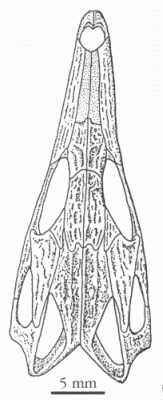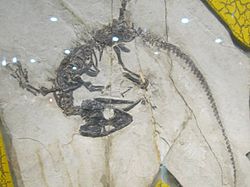
| Palaeos |  |
Choristodera |
| Vertebrates | Choristodera |
| Page Back | Unit Home | Unit Dendrogram | Unit References | Taxon Index | Page Next |
| Unit Back | Vertebrates Home | Vertebrate Dendrograms | Vertebrate References | Glossary | Unit Next |
|
Abbreviated Dendrogram
DIAPSIDA |?-CHORISTODERA | |--Lazarussuchus | `--+--Cteniogenys | `--+--Hyphalosaurus | |--Monjurosuchus | `--Neochoristodera |--ARCHOSAUROMORPHA `--LEPIDOSAUROMORPHA |
Contents
|
Choristodera: .
Range: Late Triassic (Rhaetian) to early Miocene of North America, Asia, and Europe
Phylogeny: Younginformes or Archosauromorpha : * : Cteniogenys + (Monjurosuchus + Neochoristodera)
Links: Wikipedia ATW010715 and MAK101008
Lazarussuchus: L. inexpectatus Hecht, 1992 (type species), L. dvoraki Evans and Klembara, 2005
Range: late Oligocene and early Miocene of France and the Czech Republic. .
Phylogeny: Choristodera : (Cteniogenys + (Hyphalosaurus + Monjurosuchus + Neochoristodera)) + *.
Comments: a small lizard-like animal, the most basal choristoderan, as well as the most recent. Assuming morphology based cladistic analysis is correct, and also assuming no reversals (secomdary loss of advanced characteristics) this implies a long ghost lineage. The name refers to the biblical Lazarus, who rose from the dead, just as this species existed long after the last choristoderans became extinct in the Eocene; hence, "lazarus taxon". MAK120707
 |
| Cteniogenys antiquus from the Bathonian of England. Illustration from Evans & Milner 1994 |
Cteniogenys: Cteniogenys antiquus Gilmore, 1928.
Range: Middle (Bathonian) to Late (Kimmeridgian-Thithonian) Jurassic of Western Laurasia (Europe and North America)
Phylogeny: Choristodera : Lazarussuchus + ((Hyphalosaurus + Monjurosuchus + Neochoristodera) + *).
Characters: short snout, elongated and laterally (sideways) facing orbits. Matsumoto et al 2007 p.344
Comments: a small bodied, lizard like animal, the most primitive Choristoderan (the status of the late surviving Lazarussuchus, sometimes considered the most primitive, is unclear). The same species, Cteniogenys antiquus, is given for both the Bathonian (Evans & Milner 1994) and Kimmeridgian-Thithonian species. Since it is unlikely that a single species would persoist unchanged for so long, these probably are two distinct but very similar forms
Links: Wikipedia MAK101008
 |
| Hyphalosaurus lingyuanensis, on display at the Paleozoological Museum of China. Photo © Captmondo,Wikipedia |
Hyphalosaurus: H. lingyuanensis Gao, Tang & Wang, 1999 (type), H. baitaigouensis Ji et al., 2004
Horizon: Jehol Biota - Yixian Formation; Mid Cretaceous (Aptian) of China.
Phylogeny: Choristodera : Lazarussuchus + (Cteniogenys + (Monjurosuchus + Neochoristodera + *)).
Comments: A choristoderan mimicking a sauropterygian, this small freshwater reptile is distinguishe dby the astronishingly long neck. It is known from thousands of specimens representing a complete growth seqyuence. H. baitaigouensis seems to have lived slightly later, and is distinguished by the larger number of neck vertebrae 26 instead of 19. This implies an anagenetic series (straight line evolution), with the animals developing progressively more flexible necks over time. In other respects the two species are identical, and both reach a length of 80 cm. The related and more or less contemporary Shokawa ikoi from Japan was very similar, but more about twice as long
Links: Wikipedia (detailed coverage)
 |
| Monjurosuchus splendens, Yixian Formation, Early Cretaceous (Hauterivian–Barremian) of western Liaoning, China; from the Beijing Museum. Wikipedia |
Monjurosuchus: Monjurosuchus splendens, Monjurosuchus sp.
Range: Early Cretaceous (Berriasian to Barremian) of Japan and China.
Phylogeny: Choristodera : Lazarussuchus + (Cteniogenys + (Hyphalosaurus + Neochoristodera + *)).
Characters: relatively short neck (cervical vertebral count of eight rather than the usual nine), short rounded snout (or preorbital region to give the technical term), narrow, fused frontal bones, closed lower temporal fenestrae, large dorsally (upward) directed orbits
Comments: A small (skull 8 cm long and 5 wide), semi-aquatic form. Hyphalosaurus, Lazarussuchus, and Monjurosuchus have a similar head type, but Lazarussuchus is originaruily or secodnarily) more primitive and Hyphalosaurus is a specialised form distinguished by its very long neck.
References: Matsumoto et al 2007. MAK101008
Links: Wikipedia
| Page Back | Unit Home | Page Top | Page Next |
checked ATW050908
Using this material. All material by ATW is public domain and may be freely used in any way (also any material jointly written by ATW and MAK). All material by MAK is licensed Creative Commons Attribution License Version 3.0, and may be freely used provided acknowedgement is given. All Wikipedia material is either Gnu Open Source or Creative Commons (see original Wikipedia page for details). Other graphics are copyright their respective owners